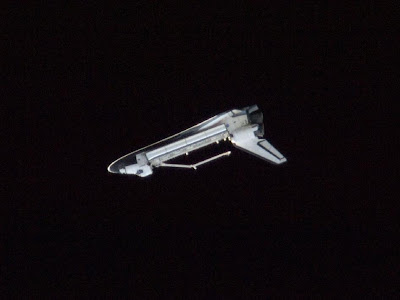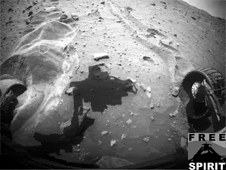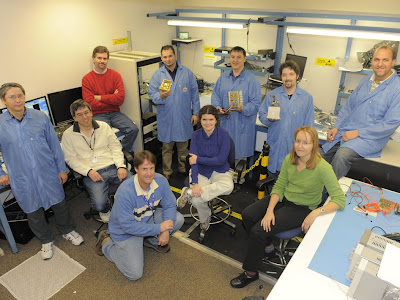wish you happy prosperous new year

 Saturn's moons give Tchaikovsky's classic ballet, "The Nutcracker," a graceful new spin in this video compiled from some 61 images taken by the Cassini spacecraft.
Saturn's moons give Tchaikovsky's classic ballet, "The Nutcracker," a graceful new spin in this video compiled from some 61 images taken by the Cassini spacecraft.
 NASA astronaut T.J. Creamer, Russian cosmonaut Oleg Kotov and Japan Aerospace Exploration Agency astronaut Soichi Noguchi docked with their new home at 5:48 p.m. EST Tuesday. The trio launched aboard the Soyuz TMA-17 spacecraft at 4:52 p.m. Sunday from the Baikonur Cosmodrome in Kazakhstan.
NASA astronaut T.J. Creamer, Russian cosmonaut Oleg Kotov and Japan Aerospace Exploration Agency astronaut Soichi Noguchi docked with their new home at 5:48 p.m. EST Tuesday. The trio launched aboard the Soyuz TMA-17 spacecraft at 4:52 p.m. Sunday from the Baikonur Cosmodrome in Kazakhstan. High above the Earth, the International Space Station’s Expedition 22 crew kept busy with science and maintenance Monday as they awaited Tuesday’s scheduled arrival of additional crew members.
High above the Earth, the International Space Station’s Expedition 22 crew kept busy with science and maintenance Monday as they awaited Tuesday’s scheduled arrival of additional crew members. Space shuttle Endeavour was lowered onto the mobile launcher platform and attached to the massive external fuel tank and twin solid rocket boosters. Early in January the entire stack will be rolled out to Launch Pad 39A for the STS-130 mission to the International Space Station.
Space shuttle Endeavour was lowered onto the mobile launcher platform and attached to the massive external fuel tank and twin solid rocket boosters. Early in January the entire stack will be rolled out to Launch Pad 39A for the STS-130 mission to the International Space Station. NASA, Alliant Techsystems (ATK) and Lockheed Martin performed a ground test of a full-scale attitude control motor for the launch abort system of the Orion crew exploration vehicle. The test was conducted at ATK's facility in Elkton, Md.
NASA, Alliant Techsystems (ATK) and Lockheed Martin performed a ground test of a full-scale attitude control motor for the launch abort system of the Orion crew exploration vehicle. The test was conducted at ATK's facility in Elkton, Md.  The Soyuz TMA-17 spacecraft is rolled out by train to the launch pad at the Baikonur Cosmodrome, Kazakhstan, Friday, Dec. 18, 2009. The launch of the Soyuz spacecraft with Expedition 22 NASA Flight Engineer Timothy J. Creamer of the U.S., Soyuz Commander Oleg Kotov of Russia and Flight Engineer Soichi Noguchi of Japan, is scheduled for Monday, Dec., 21, 2009 at 3:52a.m. Kazakhstan time.
The Soyuz TMA-17 spacecraft is rolled out by train to the launch pad at the Baikonur Cosmodrome, Kazakhstan, Friday, Dec. 18, 2009. The launch of the Soyuz spacecraft with Expedition 22 NASA Flight Engineer Timothy J. Creamer of the U.S., Soyuz Commander Oleg Kotov of Russia and Flight Engineer Soichi Noguchi of Japan, is scheduled for Monday, Dec., 21, 2009 at 3:52a.m. Kazakhstan time. Commander Jeff Williams and Flight Engineer Maxim Suraev were busy aboard the International Space Station Thursday with a variety of maintenance activities and science experiments as they await the arrival of the remainder of the Expedition 22 crew.
Commander Jeff Williams and Flight Engineer Maxim Suraev were busy aboard the International Space Station Thursday with a variety of maintenance activities and science experiments as they await the arrival of the remainder of the Expedition 22 crew. NASA's Kennedy Space Center in Florida, technicians are completing the shuttle interface and hydraulic leak tests in the Vehicle Assembly Building today.
NASA's Kennedy Space Center in Florida, technicians are completing the shuttle interface and hydraulic leak tests in the Vehicle Assembly Building today. Space shuttle Endeavour was lowered onto the mobile launcher platform and attached to the massive external fuel tank and twin solid rocket boosters. Early in January the entire stack will be rolled out to Launch Pad 39A for the STS-130 mission to the International Space Station.
Space shuttle Endeavour was lowered onto the mobile launcher platform and attached to the massive external fuel tank and twin solid rocket boosters. Early in January the entire stack will be rolled out to Launch Pad 39A for the STS-130 mission to the International Space Station.
 WISE is designed to detect the infrared glow of hundreds of millions of objects besides asteroids and comets. It will detect new galaxies, stars, and brown dwarfs, creating a vast catalog of millions of images. These will be used to find new targets for the Spitzer Space Telescope and the Herschel Space Observatory, two other observation missions which focus on specific infrared objects for study.
WISE is designed to detect the infrared glow of hundreds of millions of objects besides asteroids and comets. It will detect new galaxies, stars, and brown dwarfs, creating a vast catalog of millions of images. These will be used to find new targets for the Spitzer Space Telescope and the Herschel Space Observatory, two other observation missions which focus on specific infrared objects for study. The United Launch Alliance Delta II rocket with NASA’s Wide-field Infrared Survey Explorer (WISE) satellite aboard lifts off from Space Launch Complex-2 at Vandenberg Air Force Base in California.
The United Launch Alliance Delta II rocket with NASA’s Wide-field Infrared Survey Explorer (WISE) satellite aboard lifts off from Space Launch Complex-2 at Vandenberg Air Force Base in California. The X-15 hypersonic research aircraft flew 199 missions and gathered valuable data to help future generations of high-speed aircraft.
The X-15 hypersonic research aircraft flew 199 missions and gathered valuable data to help future generations of high-speed aircraft.
 Commander George Zamka will lead the STS-130 mission to the International Space Station aboard space shuttle Endeavour. Terry Virts will serve as the pilot. Mission specialists are Nicholas Patrick, Robert Behnken, Stephen Robinson and Kathryn Hire. Virts will be making his first trip to space.
Commander George Zamka will lead the STS-130 mission to the International Space Station aboard space shuttle Endeavour. Terry Virts will serve as the pilot. Mission specialists are Nicholas Patrick, Robert Behnken, Stephen Robinson and Kathryn Hire. Virts will be making his first trip to space. Researchers at NASA's Langley Research Center in Hampton, Va., are testing the "deployable energy absorber" with the help of a helicopter donated by the Army, a crash test dummy contributed by the Applied Physics Laboratory in Laurel, Md., and a 240-foot (73.2 m) tall structure once used to teach astronauts how to land on the moon.
Researchers at NASA's Langley Research Center in Hampton, Va., are testing the "deployable energy absorber" with the help of a helicopter donated by the Army, a crash test dummy contributed by the Applied Physics Laboratory in Laurel, Md., and a 240-foot (73.2 m) tall structure once used to teach astronauts how to land on the moon. A sort of "honeycomb airbag" created to cushion future astronauts may end up in helicopters to help prevent injuries instead.
A sort of "honeycomb airbag" created to cushion future astronauts may end up in helicopters to help prevent injuries instead.




http://www.nasa.gov/station








Spirit's right-rear wheel stalled again on Sol 2099 (Nov. 28, 2009) during the first step of a two-step extrication maneuver. This stall is different in some characteristics from the stall on Sol 2092 (Nov. 21). The Sol 2099 stall occurred more quickly and the inferred rotor resistance was elevated at the end of the stall. Investigation of past stall events along with these characteristics suggest that this stall might not be result of the terrain, but might be internal to the right-rear wheel actuator. Rover project engineers are developing a series of diagnostics to explore the actuator health and to isolate potential terrain interactions. These diagnostics are not likely to be ready before Wednesday. Plans for future driving will depend on the results of the diagnostic tests.
Before the Sol 2099 drive ended, Spirit completed 1.4 meters of wheel spin and the rover's center moved 0.5 millimeters (0.02 inch) forward, 0.25 millimeters (0.01 inch) to the left and 0.5 millimeters (0.02 inch) downward. Since Spirit began extrication on Sol 2088, the rover has performed 9.5 meters (31 feet) of wheel spin and the rover's center, in total, has moved 16 millimeters (0.63 inch) forward, 10 millimeters (0.39 inch) to the left and 5 millimeters (0.20 inch) downward.


A spring heat wave scorched southeastern Australia in mid-November 2009, pushing the fire danger to the “catastrophic” category in parts of South Australia and New South Wales and to “extreme” in other surrounding areas. Many cities, including Melbourne and Adelaide experienced record-breaking temperatures that continued for many days.
This pair of images illustrates the impact of the heatwave on the land surface temperatures—which are different from the air temperatures reported in the daily weather report—across the continent. Based on observations from the Moderate Resolution Imaging Spectroradiometer (MODIS) on NASA’s Terra satellite, the maps show where temperatures from November 9–16 (left) and November 17–24 (right) were warmer or cooler than the average for those same eight-day periods between 2000–2008.
Around Adelaide in South Australia and Melbourne in Victoria, the land surface temperatures were up to 12 degrees Celsius (22 degrees Fahrenheit) above average in mid-November. For Adelaide, the event was the first springtime heatwave since records began in 1887, according to the Australian Bureau of Meteorology. The city had temperatures above 35 degrees Celsius (95 Fahrenheit) for 8 consecutive days. (Five days at those temperatures constitutes a heatwave). Later in the month, some areas experienced heavy rain, which broke the heatwave in some areas, but not all.
According to the weather and climate agency, the heat wave resulted from a combination of factors: gradually rising temperatures across southern Australia, probably as a result of global warming; an El Niño event in the Pacific Ocean; and a high-pressure weather system that stalled out over the Tasman Sea to the southeast, causing hot, dry winds to blow south over continent.




